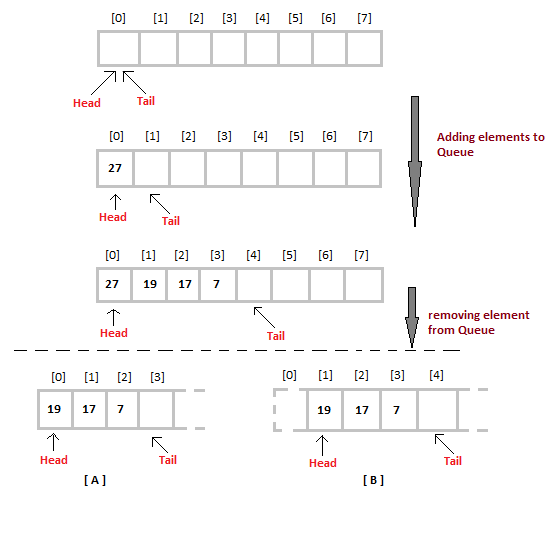Queue is also an abstract data type or a linear data structure, just like stack data structure, in which the first element is inserted from one end called the REAR(also called tail), and the removal of existing element takes place from the other end called as FRONT(also called head).
前言 队列的两个基本操作:入队 将一个数据放到队列尾部;出队 从队列的头部取出一个元素。队列也是一种操作受限的数据结构,支持队尾插入元素,在队头删除元素。队列遵循FIFO先入先出的原则。
思路 环形队列
思路如下:
front 变量的含义做一个调整: front 就指向队列的第一个元素, 也就是说 arr[front] 就是队列的第一个元素。front 的初始值 = 0;
rear 变量的含义做一个调整:rear 指向队列的最后一个元素的后一个位置. 因为希望空出一个空间做为约定。rear 的初始值 = 0;
当队列满时,条件是 (rear + 1) % maxSize == front 【满】;
对队列为空的条件, rear == front 【空】;
当我们这样分析, 队列中有效的数据的个数 (rear + maxSize - front) % maxSize ;
我们就可以在原来的队列上修改得到,一个环形队列。
进队出队过程:
代码 1 2 3 4 5 6 7 8 9 10 11 12 13 14 15 16 17 18 19 20 21 22 23 24 25 26 27 28 29 30 31 32 33 34 35 36 37 38 39 40 41 42 43 44 45 46 47 48 49 50 51 52 53 54 55 56 57 58 59 60 61 62 63 64 65 66 67 68 69 70 71 72 73 74 75 76 77 78 79 80 81 82 83 84 85 86 87 88 89 90 91 92 93 94 95 96 97 98 99 100 101 102 103 104 105 106 107 108 109 110 111 112 113 114 115 116 117 118 119 120 121 122 123 124 125 126 127 128 129 130 131 132 133 134 135 136 137 138 139 140 141 142 143 144 145 146 147 148 149 150 151 152 153 154 155 156 157 158 159 160 161 162 163 164 165 166 167 168 169 170 171 172 173 174 175 176 177 178 179 180 181 182 183 184 185 import java.util.Scanner;public class Queue public static void main (String[] args) System.out.println("测试数组模拟环形队列" ); CircleArrayQueue queue = new CircleArrayQueue(4 ); char c; Scanner scanner = new Scanner(System.in); boolean loop = true ; while (loop) { System.out.println("a(add) : 队列添加数据" ); System.out.println("g(get) : 从队列取数据" ); System.out.println("h(head) : 获取队列头部数据" ); System.out.println("s(show) : 显示队列所有数据" ); System.out.println("e(exit) : 退出程序" ); c = scanner.next().charAt(0 ); switch (c) { case 'a' : System.out.println("请输入一个数:" ); int val = scanner.nextInt(); queue.addQueue(val); System.out.printf("当前队列的头部指针:%d,尾部指针:%d\n" , queue.getFront(), queue.getRear()); break ; case 'g' : try { int n = queue.getQueue(); System.out.println("从队列取出数据:" + n); System.out.printf("当前队列的头部指针:%d,尾部指针:%d\n" , queue.getFront(), queue.getRear()); } catch (Exception e) { System.out.println(e.getMessage()); } break ; case 'h' : try { int n = queue.headQueue(); System.out.println("队列的头部数据:" + n); System.out.printf("当前队列的头部指针:%d,尾部指针:%d\n" , queue.getFront(), queue.getRear()); } catch (Exception e) { System.out.println(e.getMessage()); } break ; case 's' : queue.showQueue(); System.out.printf("当前队列的头部指针:%d,尾部指针:%d\n" , queue.getFront(), queue.getRear()); break ; case 'e' : scanner.close(); loop = false ; break ; default : break ; } } System.out.println("退出程序" ); } } class CircleArrayQueue private int maxSize; private int front; private int rear; private int [] arr; public CircleArrayQueue (int maxSize) this .maxSize = maxSize; this .front = 0 ; this .rear = 0 ; this .arr = new int [maxSize]; } private boolean isFull () return (rear + 1 ) % maxSize == front; } private boolean isEmpty () return front == rear; } public void addQueue (int number) if (isFull()) { throw new RuntimeException("队列已满" ); } arr[rear] = number; rear = (rear + 1 ) % maxSize; } public int getQueue () if (isEmpty()) { throw new RuntimeException("队列为空" ); } int value = arr[front]; front = (front + 1 ) % maxSize; return value; } public void showQueue () if (isEmpty()) { throw new RuntimeException("队列为空" ); } for (int i = front; i < front + size(); i++) { System.out.println("arr[" + i % maxSize + "]=" + arr[i % maxSize]); } System.out.println("front=" + front); System.out.println("rear=" + rear); } public int headQueue () if (isEmpty()) { throw new RuntimeException("队列为空" ); } return arr[front]; } public int getFront () return front; } public int getRear () return rear; } private int size () return (rear + maxSize - front) % maxSize; } }
延伸 队列:彻底理解队列 环形队列介绍与实现 数据结构之环形队列 韩顺平数据结构和算法 What is a Queue Data Structure?
<
Design Patterns(二) Factory
Data Structure Sparse Array
>


